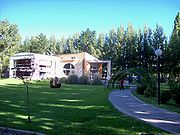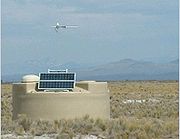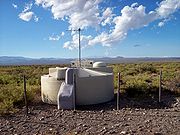
Pierre Auger Observatory
Encyclopedia



Cosmic ray
Cosmic rays are energetic charged subatomic particles, originating from outer space. They may produce secondary particles that penetrate the Earth's atmosphere and surface. The term ray is historical as cosmic rays were thought to be electromagnetic radiation...
observatory
Observatory
An observatory is a location used for observing terrestrial or celestial events. Astronomy, climatology/meteorology, geology, oceanography and volcanology are examples of disciplines for which observatories have been constructed...
designed to detect ultra-high-energy cosmic ray
Ultra-high-energy cosmic ray
In astroparticle physics, an ultra-high-energy cosmic ray or extreme-energy cosmic ray is a cosmic ray with an extreme kinetic energy, far beyond both its rest mass and energies typical of other cosmic rays....
s: single sub-atomic particles (proton
Proton
The proton is a subatomic particle with the symbol or and a positive electric charge of 1 elementary charge. One or more protons are present in the nucleus of each atom, along with neutrons. The number of protons in each atom is its atomic number....
s or atomic nuclei
Atomic nucleus
The nucleus is the very dense region consisting of protons and neutrons at the center of an atom. It was discovered in 1911, as a result of Ernest Rutherford's interpretation of the famous 1909 Rutherford experiment performed by Hans Geiger and Ernest Marsden, under the direction of Rutherford. The...
) with energies beyond 1020 eV
Electronvolt
In physics, the electron volt is a unit of energy equal to approximately joule . By definition, it is equal to the amount of kinetic energy gained by a single unbound electron when it accelerates through an electric potential difference of one volt...
(about the energy of a tennis ball
Tennis ball
A tennis ball is a ball designed for the sport of tennis,approximately 6.7 cm in diameter. Tennis balls are generally bright green, but in recreational play can be virtually any color. Tennis balls are covered in a fibrous fluffy felt which modifies their aerodynamic properties...
traveling at 80 km/h). These high energy particles have an estimated arrival rate of just 1 per km2 per century, therefore the Auger Observatory has created a detection area the size of Rhode Island
Rhode Island
The state of Rhode Island and Providence Plantations, more commonly referred to as Rhode Island , is a state in the New England region of the United States. It is the smallest U.S. state by area...
— over 3000 km² (1,158.3 sq mi) — in order to record a large number of these events. It is located in western Argentina
Argentina
Argentina , officially the Argentine Republic , is the second largest country in South America by land area, after Brazil. It is constituted as a federation of 23 provinces and an autonomous city, Buenos Aires...
's Mendoza Province
Mendoza Province
The Province of Mendoza is a province of Argentina, located in the western central part of the country in the Cuyo region. It borders to the north with San Juan, the south with La Pampa and Neuquén, the east with San Luis, and to the west with the republic of Chile; the international limit is...
, in one of the South American Pampas.
The observatory was named after the French physicist Pierre Victor Auger
Pierre Victor Auger
Pierre Victor Auger was a French physicist, born in Paris. He worked in the fields of atomic physics, nuclear physics, and cosmic ray physics....
. The project was proposed by Jim Cronin and Alan Watson in 1992. Today, almost 500 physicist
Physicist
A physicist is a scientist who studies or practices physics. Physicists study a wide range of physical phenomena in many branches of physics spanning all length scales: from sub-atomic particles of which all ordinary matter is made to the behavior of the material Universe as a whole...
s from 55 institutions around the world are collaborating to build the southern site. The 15 participating countries are sharing the $50 million construction budget, each providing a small portion of the total cost.
Overview
The observatory has been taking production-grade dataScientific data archiving
Scientific data archiving refers to the long-term storage of scientific data and methods. The various scientific journals have differing policies regarding how much of their data and methods scientists are required to store in a public archive, and what is actually archived varies widely between...
since 2005 and was officially completed in 2008. In 2003, it became the largest ultra-high energy cosmic ray detector in the world. It is located on the vast plain of Pampa Amarilla, near the town of Malargüe
Malargüe
- Transport and infrastructures :- Transportation :Malargüe is linked to the north of Mendoza by National Route 40. This route continues south, entering Neuquén Province, but is only partially built and not well maintained beyond Malargüe City....
in Mendoza Province
Mendoza Province
The Province of Mendoza is a province of Argentina, located in the western central part of the country in the Cuyo region. It borders to the north with San Juan, the south with La Pampa and Neuquén, the east with San Luis, and to the west with the republic of Chile; the international limit is...
, Argentina
Argentina
Argentina , officially the Argentine Republic , is the second largest country in South America by land area, after Brazil. It is constituted as a federation of 23 provinces and an autonomous city, Buenos Aires...
. The basic set-up consists of 1600 water tanks (water Cherenkov Detectors
Cherenkov detector
A Cherenkov detector is a particle detector using the mass-dependent threshold energy of Cherenkov radiation. This allows a discrimination between a lighter particle and a heavier particle ....
, similar to the Haverah Park experiment
Haverah Park experiment
The Haverah Park experiment was a cosmic ray air shower detection array consisting of water Cherenkov detectors distributed over an area of 12 km2on Haverah Park on the Pennine moorland near Harrogate, North Yorkshire...
) distributed over 3000 square kilometres (1,158.3 sq mi), along with four atmospheric fluorescence
Fluorescence
Fluorescence is the emission of light by a substance that has absorbed light or other electromagnetic radiation of a different wavelength. It is a form of luminescence. In most cases, emitted light has a longer wavelength, and therefore lower energy, than the absorbed radiation...
detectors (similar to the High Resolution Fly's Eye
High Resolution Fly's Eye Cosmic Ray Detector
The High Resolution Fly's Eye or HiRes detector was an ultra-high-energy cosmic ray observatory that operated in the western Utah desert from May 1997 until April 2006. HiRes utilized the atmospheric fluorescence technique that was pioneered by the Utah group first in tests at the Volcano Ranch...
) overseeing the surface array. Work is ongoing on upgrades to the observatory, including:
- three additional fluorescence telescopes, capable of covering higher altitudes (HEAT — High Elevation Auger Telescopes)
- two higher-density nested arrays of surface detectors combined with underground muon counters (AMIGA — Auger Muons and Infill for the Ground Array)
- a prototype radiotelescope array (AERA — Auger Engineering Radio Array) for detecting radioemission from the shower cascade, in the frequency range 30-80 MHz
- R&D on detecting microwave emission from shower electrons (frequencies around 4 GHz)
The Pierre Auger Observatory is unique in that it is the first experiment that combines both ground and fluorescence detectors at the same site thus allowing cross-calibration and reduction of systematic effects that may be peculiar to each technique. The Cherenkov detectors use 3 large photomultiplier tubes to detect the Cherenkov radiation
Cherenkov radiation
Cherenkov radiation is electromagnetic radiation emitted when a charged particle passes through a dielectric medium at a speed greater than the phase velocity of light in that medium...
produced by high-energy particles passing through water in the tank. The time of arrival of high-energy particles from the same shower at several tanks is used to calculate the direction of travel of the original particle. The fluorescence detectors are used to track the particle shower's glow on cloudless moonless nights, as it descends through the atmosphere.
The Pierre Auger Collaboration has made available (for outreach purposes) 1% of the full ground array data set. This data can be explored at the Public Event Display web site.
In November 2007, it was announced that the observatory had found a correlation between the 27 highest energy events and nearby active galactic nuclei (AGN). This would suggest that these events are triggered by protons that were emitted by objects correlated with the AGN distribution of matter. Acceleration by the large magnetic fields associated with the massive central black hole
Black hole
A black hole is a region of spacetime from which nothing, not even light, can escape. The theory of general relativity predicts that a sufficiently compact mass will deform spacetime to form a black hole. Around a black hole there is a mathematically defined surface called an event horizon that...
s that form the AGNs is one possibility.
Postage stamps
Argentina issued 100,000 postage stampPostage stamp
A postage stamp is a small piece of paper that is purchased and displayed on an item of mail as evidence of payment of postage. Typically, stamps are made from special paper, with a national designation and denomination on the face, and a gum adhesive on the reverse side...
s honouring the observatory on 14 July 2007. The stamp shows a surface detector tank in the foreground, a building of fluorescence detectors in the background, and the expression "1020 eV" in large lettering.
Further reading
- November 2007 AGN Press Release
- Correlation of the Highest-Energy Cosmic Rays with Nearby Extragalactic Objects: ScienceScience (journal)Science is the academic journal of the American Association for the Advancement of Science and is one of the world's top scientific journals....
2007 (subscription required). Arxiv preprint (free but not official). - Let It Rain Symmetry February 2005
External links
- Official website
- Public Event Display
- Southern site website (Spanish and English)
- COSMUS – visuals for the PAO: includes movies, animated 3d models of cosmic ray showers over the Malargues site, and stereo photographs.
- ASPERA European astroparticle physics network
- Astroparticle.org – European astroparticle physics portal
- Detecting Cosmic Rays: The Auger Observatory and Frontier Science – Interview with Angela Olinto (video)

